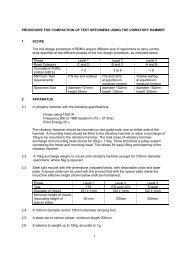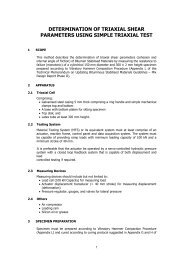Updating Bituminous Stabilized Materials Guidelines Mix Design Report Phase II
Moisture Sensitivity: Part II (Validation) - Asphalt Academy
Moisture Sensitivity: Part II (Validation) - Asphalt Academy
- No tags were found...
You also want an ePaper? Increase the reach of your titles
YUMPU automatically turns print PDFs into web optimized ePapers that Google loves.
1. BACKGROUND AND INTRODUCTION<br />
1.1. Terms of Reference<br />
Moisture ingress has a detrimental influence on BSMs, both in terms of stiffness and strength of<br />
the material. In order to develop more reliable laboratory testing techniques, a more robust link<br />
between laboratory properties of the material and field performance needs to be established.<br />
Accelerated Pavement Testing (APT) with devices such as the MMLS3 can serve to provide that<br />
link.<br />
The advantages of APT testing include the evaluation of a range of variables in a relatively short<br />
period of time. This is particularly applicable to BSMs because ranges of different types of<br />
binders used in practice, namely:<br />
• Emulsion<br />
• Emulsion and Cement<br />
• Foam Bitumen<br />
• Foam Bitumen and Cement<br />
Each of these binders, along with the aggregates, reacts differently to exposure to moisture.<br />
The knowledge and understanding of the mechanisms of moisture damage and the main factors<br />
influencing the deterioration need further extension. In addition, reliable limits need<br />
establishment for tests on materials exposed to moisture. Variables such as binder types,<br />
aggregate types, active fillers, compaction, curing, manner and harshness of moisture exposure,<br />
as well as the impact on material properties, requires investigation.<br />
1.2. Task Objectives<br />
In terms of the findings of the Inception Study report, the objectives of Task 10 were to:<br />
• Investigate accelerated pavement testing procedures using an MMLS3 on various<br />
<strong>Bituminous</strong> Stabilised <strong>Materials</strong> (BSMs) including moisture exposure,<br />
• Investigate the performance of the BSMs above with water exposure, using wheel<br />
tracking tests, and<br />
• Validate the behaviour of the selected durability/moisture sensitivity test method<br />
outlined above with the results of the accelerated tests.<br />
• Make appropriate recommendations regarding the use of the APT device on the<br />
screening BSMs based on the moisture related damage.<br />
Task 9 has outlined the development of the Moisture Induced Sensitivity Test (MIST) apparatus<br />
that developed for the conditioning of triaxial specimens for the evaluation of the resistance to<br />
moisture of these materials. The objective of Task 10, in short, is therefore to validate the<br />
2












